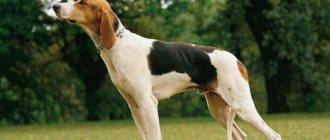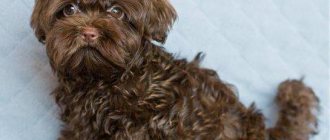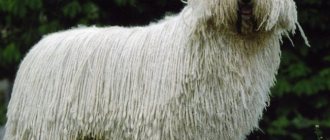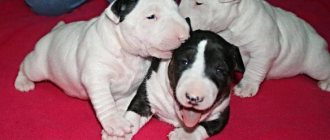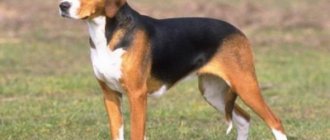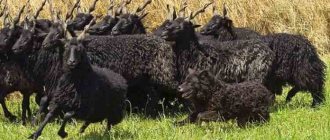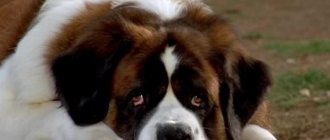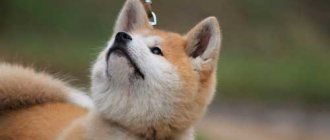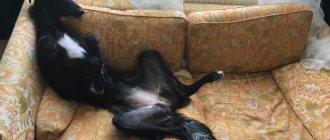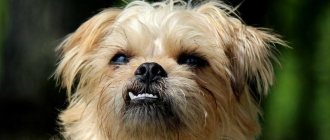History of the breed
The author of the breed is Yulia Lakatosh, a livestock specialist, dog handler and international judge all rolled into one. Living in Moscow, Yulia got the idea to create a dog with which the Russian elite could appear at receptions. Judging by the external features and description, the breed was based on Yorkshire terriers, long-haired red terriers and Pekingese. However, the dog handler keeps the entire chain involved in crossing a secret.
The first purebred offspring of “mermaids” were obtained at the beginning of the 21st century. It turns out that the Russian salon breed is a very young and still small breed. The triumphant public appearance took place in 2013, when the dogs shown won the hearts of thousands of fans. In 2016, a record of copyright documents in the name of Lakatosh appeared in the metrics and documents of the RKF. The breed standard is registered in the FCI in group No. 9.
Story
It should be noted right away that the Russian salon dog, which is often called the “mermaid,” is a relatively young breed, work on which began in the capital of Russia at the beginning of the new millennium. The author and main breeder of the new group of dogs is Yu. A. Lakatosh, who has impressive canine experience (more than 30 years).
At the first stage of breeding “mermaids,” planned crossings of dogs between breeds were carried out in order to obtain a variety of representatives for the further development of the breed in one direction or another.
Then, thanks to reproductive crossing, the breeder managed to achieve the consolidation of the most desirable characteristics of the dogs, after which all that remained was to complete the main mission - breeding a group of animals with the most suitable, selected characteristics and consolidating the phenotype.
Today, matings of Russian salon dogs mostly take place within this breed group, which received recognition from the RKF back in 2013.
Important! Some dog breeders call the Russian salon dog a designer breed, however, according to its founders, it is a designer breed, which, unlike the intended variant, is subject to breeding and fixation of certain qualities.
It must be said that the list of breeds used in the past to create it is still unknown and has not been disclosed by the author, although it was previously reported about the presence of Yorkshire terrier blood in the current “mermaids” - which, however, is easy to notice just by looking at it.
How to choose a puppy?
Since the breed is still young, it has not received sufficient distribution throughout the world. Today, Moscow mermaid puppies can only be purchased in specialized private nurseries. Breeders do not recommend purchasing dogs through dubious advertisements, especially via the Internet, in light of the fact that under the guise of a purebred dog they can sell an ordinary mixed breed.
When choosing a pet, you should pay attention to the documentation about the dog; today, all litters of Russian salon dogs are subject to mandatory registration. You can verify the purebredness of the animal by submitting a request for verification on the nursery website
You cannot buy a dog without documents - while the animals are considered exclusive, they stand out for their high cost. The cheapness of a small dog should alert a potential buyer
When choosing a pet, it is recommended to pay attention to its exterior and check its characteristics in accordance with established standards for the breed
How much do mermaid puppies cost?
The new breed has a short history; salon dog puppies are not available for public sale, which explains the impressive price. The cost of babies is 20-60 thousand rubles and depends on the following indicators:
- age;
- floor;
- coat color;
- compliance with the standard;
- prospect of future matings.
When purchasing a puppy as a beautiful pet or companion, it is enough to choose pet-class puppies. Their price is much lower, it is about 7 thousand rubles.
Main types and types
Different types of Yorkies have their own characteristics. Some people like short-haired, smooth-haired or wire-haired Yorkshire terriers of large or small sizes. There are 14 varieties of this breed. Below we discuss what types of Yorkies there are.
The difference between Mini Yorkies and the breed standard
First of all, Mini Yorkies differ in their miniature size from the breed standard. Their weight varies between 1.5-2 kg. The little Yorkie is considered a fragile, calm, affectionate and flexible pet. The variety also refers to clean dogs that do not shed seasonally and do not require much attention from the owner.
For your information! The small size allows the pet to attend various events and parties with its owner. Because of this, Mini Yorkies are called pocket dogs.
Representatives of Mini Yorkshire Terriers have defects such as an open fontanel and malocclusion. Females cannot bear and give birth to healthy puppies due to critical mass. A small pet should not be left alone unattended on a bed or sofa. If he falls, he risks injury.
It is not recommended to have a Mini Yorkie for families with children. When playing with an animal, a child can seriously harm it. Larger Yorkie varieties are suitable for children.
Super mini
This is another variety of pocket Yorkie. The weight of a super mini terrier reaches 1-1.5 kg. The height does not exceed 20 cm. Outwardly, they are almost no different from other representatives of the breed. Peculiarities:
- medium-sized muzzle;
- short elastic body;
- wide apart ears.
The average lifespan of a Micro Yorkie is 5-9 years. This is much less than large Yorkies. They live 12-16 years.
Note! Some babies suffer due to an unstable psyche. They are not suitable for reproduction
They should not be left in a draft, alone or with children.
Baby face Yorkshire Terrier
This dog has the cutest appearance. The muzzle resembles a child's face. Distinctive features of the baby face York:
- shortened, slightly upturned muzzle;
- low-set triangular ears;
- rounded large head;
- large, protruding and widely spaced round eyes.
Such a pet suffers from early tooth loss. The dog is susceptible to conjunctivitis. Large eyes and narrowed tear ducts are to blame for this. Due to the bulge, the eyes are susceptible to injury and clogging with dust. The animal snores during sleep and makes strange sounds when running, but this does not threaten its life and well-being.
Important! Baby face can have a standard or small size, like representatives of mini or super-mini Yorkshire terriers
Russian salon
This is a Yorkie with long hair, which is distinguished by its larger size, wheaten or cognac color. His fur is much rougher to the touch than the others. It will have to be constantly combed using special products. There may be black and white spots on the paws, tail, and ears. The thick coat has an undercoat. Other features:
- weight 1.8-3.5 kg;
- height at withers 18-28 cm;
- well developed chest;
- pronounced withers.
Important! The second name of the variety is mermaid. She combines the exterior of a Yorkshire terrier, a Pekingese and a red longhaired toy terrier.
Russian salon after haircut
Biro-Yorks and Shoko-Yorks
Unlike the others, the Biro-York completely lacks dark hair. It has a tri-color color consisting of chocolate, white and golden shades. Features of the species:
- weight 3.1 kg;
- height 22 cm;
- high-set tail;
- small head with short muzzle;
- compact body.
The Choco Yorkie is a rare breed. This shorthaired Yorkie is completely chocolate colored. The color is evenly distributed throughout the body. It can be milk chocolate or rich dark chocolate. The animal is also distinguished by its medium-sized muzzle, hazel eyes, straight, long body, soft structure and long tail.
Biewer York: description of the breed
The Biewer York is another non-standard variety. The Biewer's head color combines gold, white and black. The body of the animal is painted black and white. Other distinctive features:
- height 22 cm;
- weight 2-3.5 kg;
- flattened muzzle of medium length;
- movable neck;
- flat small head.
Note! This dog is not characterized by aggressiveness. This big Yorkie loves care, attention, and is easy to train.
Main types of colors
Beaver
It has a bright, white-black-red color and a black nose, while the proportional ratio of colors can be any: along with beavers, which have a white color with small spots, there are also individuals whose main color could be called, rather, black.
However, it is the light-colored dogs that are most popular.
Biro
It is colored white-brown-red, the location of the spots and their size may vary.
There are also almost brown biros that have a slight tan and small white markings (shown in the photo).
The nose of Biro Yorkies is brown in various shades.
Goldust
The main color of the coat is golden-fawn of various tones.
May be supplemented with small white markings.
Chocolate or choco
Its color can be any of the brown tones: from light brownish to dark chocolate.
There may be some small white markings and tan, but its color is not the deep red of the Biro, but rather a pale brown.
Black
The color of his coat should be intense black.
Small white markings are acceptable, such as a white “tie” or “socks”, as well as a narrow blaze on the forehead.
White
Such dogs are very rare (shown in the photo).
Ideally they should be snow white.
The eyelids, nose and edges of the lips are only allowed to be black, and the eyes should be as dark a brown shade as possible.
A breed of dog similar to the Yorkshire Terrier
The Australian Silky Terrier, or Silky Terrier, is a dog similar to the Yorkie. Its weight varies between 3.6-4.5 kg. Height is 23 cm. The coat is fawn-blue. Silkie Terriers are considered:
- smart;
- devoted;
- fearless.
They get along with other pets and children and are able to easily carry out their owner's commands.
Be that as it may, only standard types of Yorkshire Terriers are suitable for exhibitions and competitions. Other unusual species can become loyal companions without participating in such events. The main thing is to surround him with love and care.
Popular types of Yorkshire terriers and their descriptions
To date, three types of York have been bred, differing in size:
- Standard: from 2.6 to 3.1 kg.
- Mini: from 1.5 to 2.5 kg.
- Super-mini or micro: from 1 to 1.5 kg.
All three species have the same body structure, as well as character and temperament.
The following color variations of the Yorkshire Terrier are also now known:
- standard;
- beaver;
- biro;
- goldust;
- choco;
- white;
- black.
Of all these varieties, only beavers have received official recognition. All other color variations, except for them and the standard, are considered a defect in the breed and are not allowed for exhibitions.
Baby-face Yorkies, which have a non-standard head structure and a shortened muzzle, are especially popular in the modern world.
Outwardly, these dogs look like a soft toy and can be not only standard, but also mini or micro. And the baby-face color can be any of the ones listed above.
Pets that are a cross between a Toy Terrier and a Yorkshire Terrier also look especially special. Read about this cross.
Features of maintenance and care
Mermaids are suitable for keeping in a house or apartment, like most small dogs. Short walks in the park are enough for them. Animals can be accustomed to a hygienic diaper, which is suitable for keeping in a metropolis.
Caring for a mermaid includes the following activities:
- caring for wool;
- cleaning, trimming ears;
- eye wash;
- teeth cleaning;
- nail trimming;
- walking;
- balanced diet;
- annual veterinary examination;
- vaccination;
- deworming.
Grooming
The long hair of mermaids requires constant care; it is combed at least once daily. Every 2 months the dog is taken to a professional groomer for a haircut.
The appearance of the Russian salon dog breed requires 3 types of show grooming:
- General, where the hair is cut along the contour of the head and body. The feet, base of the tail and top of the ears are trimmed very little.
- A bob, which involves a shortened cover of the body, limbs, neck and tail. At neck level, the hairs are cut in a straight horizontal line.
- A sporty cut involves the shortest length of hair with smooth transitions, and the tail is brought into the shape of a feather.
The Russian salon dog requires bathing 1-2 times a month using high quality shampoos, oils and conditioners.
Thick hair can be dried with a hairdryer, but very carefully to avoid drying out.
Walk
The Moscow salon dog, like the Yorkie, does not need a long walk. It is enough to take your pet outside twice a day for 20-30 minutes. Babies quickly get used to using a hygienic diaper, so they can be left at home in the rain or cold.
Despite the long coat, the lack of a dense undercoat forces the dog to be walked in warm, waterproof clothing if it rains or snows outside. It is recommended to keep the dog on a leash, which will prevent the mermaid from getting lost and keep her feeling safe.
Feeding
Quality nutrition is important for any dog breed. An unbalanced diet significantly affects not only the health of the mermaid, but also the condition of the coat.
Super-premium and holistic dry food made from quality ingredients provides enough nutrients, vitamins and minerals. You should ask the breeder which brand of product is suitable for the breed.
When forming a diet from natural products, you should use:
- beef, rabbit, poultry;
- zucchini, pumpkin, carrots, apples, broccoli;
- sea fish without bones;
- buckwheat, rice groats;
- low fat fermented milk products;
- beef offal;
- eggs.
- fat meat;
- cabbage, beets, tomatoes, legumes, citrus fruits;
- cereal porridge;
- flour;
- sweet;
- whole milk;
- smoked;
- salty.
Health and characteristic diseases
Despite the comparative “youth” of the Russian salon dog breed, breeders already speak with confidence about the good health and longevity of all their pets, which can be seen by carefully reading the description. There is no talk of any genetic diseases yet, but with improper care, the same problems as in other breeds are possible.
The key to the longevity of “mermaids” is a balanced diet and a responsible approach to daily care procedures, which allows these little dogs to live happily for 10 to 15 years.
Check out premium and super premium dog foods.
HEAD
HEAD: In proportion to the body. Well dressed with long hair, a pronounced “beard and mustache”, the hair on the skull should also be long.
SKULL AREA: The cranial part is round in shape, not very wide. The upper part of the skull is medium round. The forehead is quite high. The brow ridges are weakly expressed, the longitudinal groove on the skull is not pronounced. The occipital crest (tubercle) is barely noticeable.
STOP (TRANSITION FROM FOREHEAD TO MUZZLE): The transition from forehead to muzzle is well defined and deep. A longitudinal groove may be visible in the foot area.
MUZZLE AREA: Approximately one third of the length of the head.
NOSE: Small round nose, preferably black, shiny. Slight lightening, brown or gray tint is allowed. A flesh-colored lobe is acceptable, but not desirable. A “winter” nose is allowed, but not recommended.
MUZZLE: Medium depth and width. Not long, but not too short either. Not massive and heavy, and should not be too light and poorly filled under the eyes. Tapers slightly towards the nose. Covered with long hair. The bridge of the nose is straight, should be clearly visible, without folds. Located approximately at the same level with the lower eyelids of the eyes. The lower jaw is well developed and of medium width.
LIPS: Lips close-fitting, not very thin. Black or dark. Strong lightening of pigmentation is acceptable, but not desirable. Continuity of pigmentation is not required.
JAW/TEETH: Jaws well formed. Bite: scissor-shaped, pincer-shaped is possible, a dense bite without waste is acceptable. With age, the bite may change shape towards an overbite. Strong withdrawal during a snack is not welcome. It is unacceptable if the lips do not hide the teeth of the lower jaw. A full set of 6/6 incisors is desirable, but not required. All fangs are required. The teeth are not large, white.
Cheekbones: Quite flat.
EYES: Medium size, dark, shiny, not too prominent, set straight and fairly wide. The shape is oval. The lining of the eyes is dark or to match the color. The eyelids are dry and tight fitting. Light eyes are not desirable.
EARS: Erect, not large, high or medium set. In shape they are close to an equilateral triangle. The tip of the ear is not rounded. The ear material is of medium thickness, dense to the touch. Not docked. In their natural state they are dressed with long hair. The upper third of the ear must be cut short, so that the shape of the tip of the ear is visible and to give the dog a neat appearance.
NECK: Dry, fairly long, set high, graceful, smoothly widening towards the shoulder blades, medium muscled. When in motion, he carries himself proudly. The scruff is moderately expressed. The throat is without dewlaps or folds. The neck is approximately one third of the length of the body.
Appearance[edit | edit code]
The mermaid is a miniature dog, average weight from 1.8 kg to 3.5 kg, height at the withers about 20 cm, but there are individuals with a range from 18 to 28 cm.
Compact, proportional build, slightly elongated body. The head is rounded, the muzzle is medium in size with a high frontal part and a straight back of the nose, black in color. The eyes are oval in shape and always dark in color.
The body is dense, with a straight back, pronounced withers and a well-developed chest.
The tail is crescent-shaped, set high, and can be docked by 1/3.
The limbs are straight and not very long, which creates the feeling of a slightly squat silhouette.
The main feature of this breed is the variety of possible colors.
Difference from Yorkshire Terrier
Externally, dogs of the mermaid breed are noticeably reminiscent of the Yorkshire terrier, which became one of the three main breeds used to create the Russian salon dog, however, there are a number of quite significant differences between these two breeds.
Thus, the Yorkshire terrier has long limbs in relation to the body, while the mermaid has short ones.
Yorkies are allowed only one color, steel gray with red markings on some parts of the body, while mermaids can have any color. The colors in this breed are divided into two groups: “red” and “all others”. “Red” includes all colors of the red range, from light cream to almost red, “other colors” - black, brown, tan, harlequin, brindle. Any color may have white spots.
Another noticeable difference is the texture of the coat. The Yorkshire Terrier's coat is soft and smooth, completely devoid of undercoat, while the mermaid's coat is voluminous and has undercoat.
Care and health
The long silky fur of mermaids requires careful care. It does not shed, so it does not require daily combing to remove dead hair. But in order for the fur to shine, not tangle, and flow beautifully, it must be washed using a special shampoo for long-haired breeds.
After drying, apply conditioner to give the hair shine, strength, and protect it from electrification and tangling. To prevent the coat from becoming thin and dull, you need to wash your dog as it gets dirty - usually once every 2-3 weeks. The fur on the face should be washed after every meal.
Particular attention should be paid to caring for the dog's coat at the age of 9-12 months. When changing from a child's coat to an adult one, it becomes tangled and forms tangles faster than in adult dogs.
The frequency of combing depends on the quality and type of the little mermaid's fur. It varies from daily to 1-2 times a week.
You need to comb the little mermaid with a long-toothed comb made of natural material, so as not to damage the fur. A professional and owner with experience in grooming long hair can use a brush with natural bristles.
To make combing easier, the fur should be lightly moistened with water or conditioner.
Particular attention should be paid to the area around the ears, muzzle, on the inside of the paws, on the stomach
For the convenience of owners and dogs, different types of haircuts are allowed by standard:
- general grooming, in which the fur falls freely “to the floor”, but the “hairstyle” should not interfere with the animal’s movements;
- “bob” in which the hair at the bottom of the dog’s muzzle is trimmed;
- “sports” in which the head is shaped like a ball and the body is cut short.
The strand between the ears is left natural and pinned with decorative hairpins or elegant hair ties.
Standing mermaid ears do not require special care. At the top of the ear flap, the hair is clipped to reveal the shape of the ear. It is enough to regularly inspect and clean your ears once every 1-2 weeks. The eyes are wiped with damp swabs. Claws are trimmed as they grow. To prevent plaque buildup and tartar formation, you need to brush your mermaid's teeth regularly.
You should also timely inspect and prevent mermaids from external and internal parasites. Insecticides must be selected so that the animal does not become intoxicated and the blood-sucking insects die. In order for a dog to live a long time, it is necessary to carry out routine vaccinations and regular veterinary examinations.
Characteristic
So, as you probably already guessed, “mermaids” are most reminiscent of show-class pets, whose main purpose is to simply be next to a person as a companion. As for appearance, for their small size they are quite massive animals, with medium bones and square shapes.
The muzzle is not very long, the bite is scissor-shaped or pincer-shaped, although options for a tight bite or “reverse scissors” are also allowed. The bangs should not fall into the eyes, so they are always tied or pinned on the head.
The body of “mermaids” is described in one word - “compact”, with a high-set tail and long hair that flows smoothly downwards. It is divided into a parting along the back.
Important! The coat of the breed grows very quickly, therefore, in order to prevent the pet from becoming tangled and untidy, the coat should be trimmed and combed regularly.
Typically, among Russian salon dogs there are more red representatives, with colors ranging from light tones (the so-called “white gold”) to deep red and even red. In some cases, the ends of the hairs are painted black, causing the color to become “sable” or “murugi.” You can often find “little mermaids” with a dark mask on their faces, which is also allowed by the standard.
Spotty salon dogs are slightly less common, on which white markings are clearly visible on the already familiar red background. In rare cases, the white markings spread over almost the entire body, leaving the red color only in certain places.
Breed standard
When choosing a dog of a particular breed, especially for the purpose of further breeding, the new owner wants to know exactly whether his pet will meet all standards. For “mermaids” they are quite definite.
- Country of breeding : Russia.
- Height : 18-28 cm at the withers.
- Weight : 1800-3500 g (up to 0.5 kg deviation is permissible).
- Lifespan : 10-15 years.
- Shedding : moderate, but largely depends on timely washing, combing and cutting.
- Color : solid, all shades of red are most valued (for example, cognac, wheat, golden, etc.), but cream, red-white and white-red color, a dark mask on the muzzle and dark hairs on the tail are allowed.
- Litter : 4-6 puppies.
- Purpose : companion dog.
- Group : decorative dogs.
- Recognized by : RKF.
The most popular decorative dogs: dachshund, poodle, shih tzu, miniature schnauzer, chihuahua, spitz, pug, boston terrier and maltese.
Of course, this is only general information about the breed, but this is where acquaintance with it usually begins.
Application
The mermaid decorative salon dog was bred to be a devoted companion and does its job well. She sensitively senses the mood of the owner, and also knows how to adapt to him.
If the owner is resting, the pet will happily sit next to him and enjoy being scratched. And if the owner goes for a walk, the mermaid will faithfully follow him.
This breed of dog is best suited for families where there are no children or where they are old enough not to disturb the dog.
Its fragile build and small size require careful handling, which is not always possible to obtain from a small child.
A mermaid will brighten up the lives of lonely or elderly people who enjoy a measured lifestyle.
The Moscow salon dog is completely devoid of abilities for service or security activities, has no inclinations for sports achievements, and is not interested in hunting.
Character
The mermaid has a cheerful disposition and love of life. She happily spends her time playing, barks little, and loves to walk with her owner. The character of the dog can be called conflict-averse, friendly and flexible.
The Russian salon dog prefers close contact with the owner, expressed in stroking, joint activities, and encouragement. These pets easily tolerate moving and traveling, so you can safely take mermaids with you everywhere.
Unlike active terriers, the Moscow Salon Terrier is calmer and more reserved. Despite its small size, the dog is difficult to frighten or anger.
A developed mind helps them master simple commands and easily perceive education. A complete lack of attention causes bad behavior in dogs, which will only get worse with the use of punishment.
Non-compliance with standard
Not all puppies of this breed fit the definition of the standard. It is often said that no two Yorkshire Terrier puppies are alike. Sometimes, already at the age of two weeks, it becomes clear that the puppy will not be a champion - the tan marks are located chaotically, and in color they are bronze, chocolate, even whitish.
The same situation applies if the puppy is completely black or bronze or brown. These babies are readily adopted by those who simply want to keep a dog of this breed at home.
Advice! Today, the Yorkshire Terrier has a wide variety of colors in addition to the standard: chocolate York, white Yorkshire Terrier, black, white and black York, these are representatives of a new subspecies of the breed.
One of the new subspecies was bred in Germany and is called the Biewer Yorkie. These dogs' heads are colored in three shades: white, black, golden. And the body can be either black and white or white and blue.
In terms of wool composition, it is worth noting the following non-compliances with the standard:
- curly and too thick hairs;
- the fur is hard to the touch - it will not grow long and will not begin to shine;
- hair like cotton - soft, fluffy.
Such dogs are not allowed to compete.
Grooming to enhance color
If we consider the issue of animal coloring from the point of view of genetics, then it is difficult to change it. But, for example, frequent exposure to the sun will make the hair more faded and lighter.
Advice! The fur turns gray due to a lack of zinc, and if there is a lack of copper in the body, then the black and brown-red areas fade.
If you notice such changes in an adult pet, you should not be happy and show your dog in competitions. It is necessary to take the animal to the veterinarian to determine the cause of the sudden color change and subsequent treatment for the Yorkshire Terrier.
Often, breeders, in order to get puppies of the desired color, cross-breed champion dogs, resulting in puppies of the desired color. It is worth noting that you need to cross a Yorkie boy with pronounced features inherent in the standard, and a healthy Yorkie girl with good coat quality and a strong build, since childbirth in Yorkies is not easy. The male is capable of mating at the age of 9-10 months, and the female - from two years. The color of either parent may be dominant, so to maintain the quality of the breed, you need to breed its best representatives.
Hunting dogs of Russia
Among hunting dogs, the Russian greyhound is the most famous. Over the years, the breed has been used to hunt various animals. This is one of the first Russian dogs recognized by international organizations.
The dog stands out for its graceful physique. With a height of about 80 cm, her weight is only 40 kg. She has long thin legs, her head seems small against the background of her stretched, tall body. These dogs are very obedient and calm. However, in the process of hunting they show fearlessness.
The Russian hound is not currently recognized by international organizations. However, this breed has been used for hunting since the 19th century. These are medium-sized dogs with short hair (see photo). They have drooping triangular ears and a slender, muscular body. They are distinguished by high endurance, aggressiveness towards animals and friendliness towards people.
The Russian piebald hound is also considered a hunting breed. The dogs were bred in the 19th century and gained wide popularity in Europe. However, the FCI has not registered them until now. The dogs are friendly, playful and easy to care for, so they often act as companions.
The Russian hunting spaniel is a gun breed. An English Cocker Spaniel was used to breed it. However, the Russian dog is larger in size, has a more elongated body and long limbs, a light skull and less dense coat.
LIMBS
LIMBS: The length of the limbs is average. The dog should not look upturned, nor should it be too squat.
FOREQUARTERS: General appearance: When viewed from the front and side, the forelegs are fairly straight and vertical. Placed parallel to each other, not too wide.
Shoulder blades: Shoulder blades sufficiently inclined, not convex or short.
SHOULDERS: Shoulders of medium length, medium slope.
ELBOWS: Elbows point back.
FOREARMS: When viewed from the front, straight forearms are preferred.
WRISTS (CARPAL JOINT): Well formed.
PASTAR: Strong, medium slope. A parallel arrangement relative to each other is desirable.
FEET OF FRONT AND HIND LIMB: Oval, small. The fingers are quite arched. The claws and pads are pigmented in a dark color, matching the color, or flesh-colored if there is white spotting in the color.
HINDQUARTERS: General appearance: Well balanced in structure with the forequarters. When viewed from behind, they are parallel to each other. The angles are moderately pronounced.
HIPS: Hips slightly angled. The hip joints are strong and well formed.
KNEE JOINTS (KNEES): The angles of the knee joints are moderate.
SHIN: Medium length, approximately equal to the length of the thighs.
HICK JOINTS: The hock joints are dry, well defined, and the ligaments are well developed.
HEATERS: Medium length, vertical, parallel when viewed from behind.
